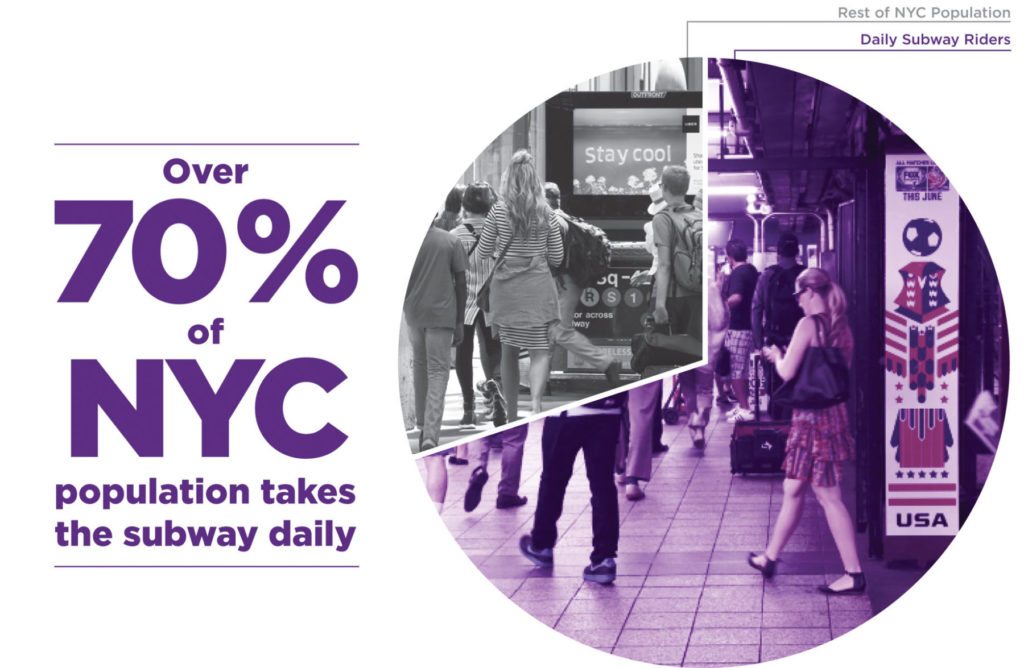 While commuting on the New York City mass transit system, my attention is inevitably drawn to the myriad of print advertisements focused on the signs and symptoms of chronic diseases. When in Boston, I am drawn to the product-specific ads that appear on subway walls.
While commuting on the New York City mass transit system, my attention is inevitably drawn to the myriad of print advertisements focused on the signs and symptoms of chronic diseases. When in Boston, I am drawn to the product-specific ads that appear on subway walls.
Intrigued by the power of commuter rail advertising for the healthcare industry, I was compelled to interview advertising and media experts about the role digital technology could play when promoting drugs and medical devices within the subway system. Apparently, we don’t have to wait long to find out.
“We are working to install digital Liveboards in transit systems in New York and Boston,” explains Glen Herskowitz, Vice President, Transit Media Development, OUTFRONT Media, one of the largest out-of-home media companies in North America and the advertising partner of choice for major municipal transit systems in the largest U.S. cities. “This digital capability will allow healthcare brands to explore a new range of creative capabilities that engage with consumers—from full motion video, interactive apps, social media, sound, and more.”
Well Suited for Disease State Messaging
“Digital capabilities in subway environments will increase the value of commuter advertising for healthcare marketers who already recognize the benefits of this medium,” asserts Cindy Machles, President of Glue Advertising. And according to Kerry Rothschild, regulatory/compliance attorney and CCC Advisory Board member, “Subway advertising is particularly well suited for disease state messages—because even partial viewing can be effective in building awareness and driving patients to their healthcare providers.”
Of course, regulatory compliance requirements will remain the same for branded ads. Drug and medical device companies need to keep risk communication and fair balance top of mind when utilizing digital subway advertising to reach consumers or patients. And disease state awareness campaigns must avoid utilizing elements that convert non-promotional messages into product promotion.
The Risk and Safety Challenge
“We can expect the FDA to apply the same standards to this kind of advertising as it does to other advertising,” says Wayne Pines, a former FDA official and CCC Advisory Board chair. “The product claims made will have to be clear and within labeling and, most challenging, there will have to be the balancing risk and safety information, and there also needs to be access to further information.” He adds, “I’m sure some companies will want to seek a review from FDA’s Office of Prescription Drug Promotion before posting ads like these for the first time.”
Digital advertising in subways will deliver the many unique features that marketers covet: A large number of commuters’ eyeballs and repeated exposure to a fixed number of messages, which are then reinforced during their daily travel routines.
For example, LCD screens can be used to “air” the equivalent of a fully branded TV commercial complete with fair balance (i.e., important safety information). Touch screens will allow for greater engagement through interactivity. Machles has been watching the subway advertising trends, and in recent years, marketers have used subway environments in cities across the nation to educate consumers about diseases and related health initiatives. For example, these include:
- Hepatitis C
- HIV/AIDS
- Tobacco use
- Smoking cessation
The calls-to-action for these initiatives are similar to those of other DTC communications: Call a phone number, visit a website, and/or ask your healthcare professional for more information.
Consumers are Primed for Messages
Subway ads can be a particularly effective way to disseminate specific and relevant content. For example, because commuters travel in dense populations, they are primed for messages about communicable diseases, such as the cold or flu. Similarly, diseases that are more prevalent in urban areas, such as asthma, may offer cost efficiencies to marketers seeking to raise awareness of diseases, as well as information about risk and prevention.
Subway environments also offer advertisers the opportunity to rapidly educate large numbers of consumers about high-prevalence diseases, such as diabetes. In addition, the subways are ideal for geo-targeted messages that have hyper-local relevance, such as a hospital, dentist, or dermatology clinic seeking to promote its services at the nearest subway stop.
“Increasingly sophisticated technology will allow for more detailed communications in the subway environment,” Herskowitz concludes. “Advertising in subway systems offers enormous frequency. The advertisements in New York alone are seen by roughly six million commuters day-in and day-out.” He adds, “Plus in densely-populated space, like a subway platform or subway car, consumers do their best to avoid looking at each other and may actually find that looking at advertisements is a relief.”



